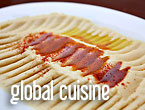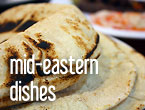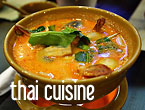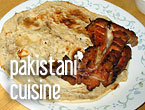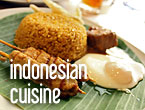Mid Eastern Cuisine: From the Gulf to the Philippines

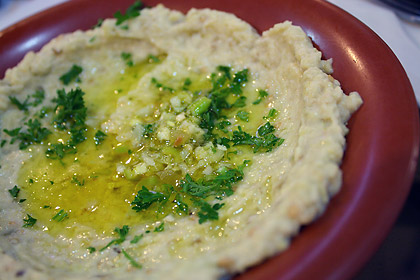
Baba ghanoush or mutabbal as served in a Mid-East restaurant in Malate, Manila.
As with other regional cuisines, Mid Eastern gastronomy is diverse while retaining a degree of similarity. Most dishes are made with tahini, a paste made from hulled seeds. Two common appetizers are made with tahini: hummus and baba ghanoush. Hummus (see picture on top) is made from mashed chickpeas blended with olive oil, lemon juice, salt, garlic and of course, tahini. Baba ghanoush (also known as mutabbal) is made from eggplant and has a smooth, creamy texture with a slightly smoky taste. We enjoy both so much that Nina learned to make hummus which she does occasionally for our own consumption or for visiting friends.
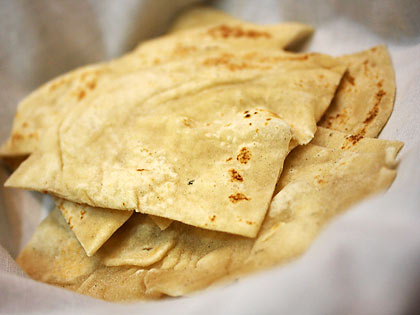
Pita bread: the top piece has just been baked over hot coals and shows its expanded size. Some dishes such as falafel are sometimes stuffed inside the pita to make a pouch-like sandwich.
We enjoy both of these two appetizers with pita bread – a staple in Mid Eastern diet. It is served in a variety of ways: baked, toasted or stuffed to form a kind of sandwich. Shawarma is an example of this kind of sandwich. Most of the time however, we use pita as a dipping bread for hummus and mutabbal or to scoop main fare such as kebab.
The ubiquitous shawarma is perhaps the most popular Mid Eastern food in the Philippines. In the classical Levantine Arab way of preparing shawarma, slabs of meat (lamb, goat, chicken, beef or any combination of these) are placed on a vertical spit and pieces are shaved off to make the shawarma while the remaining meat is kept heated. The pieces of meat are either served on a plate or made into a pita bread sandwich or wrap. In the Philippines, shawarma has become popular since the 1980s and is sold at street stalls and shopping malls. Shawarma rice has gained popularity in recent years where pita bread is replaced by rice.
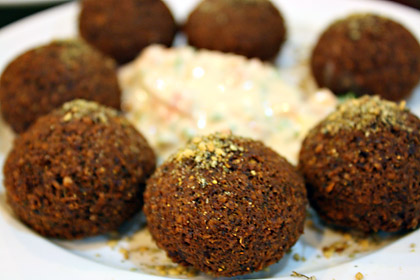
Falafel: this one was served with salad (center) and pickled vegetables at a Mid Eastern restaurant in Malate, Manila.
Perhaps the most recognized Mid Eastern dish in other countries is falafel or deep fried balls made of chick peas, onions and spices. It is often served with salads, pickled vegetables, hot sauce and tahini-based sauces. Usually served as an appetizer, it may also be served with veggies inside pita bread much like a sandwich or eaten alone. (There’s even a McFalafel sandwich at McDonald’s in some Mid Eastern cities.) Interestingly, the Coptic Christians of Egypt claim to be the inventors of falafel, using it as a replacement for meat dishes at Lent.
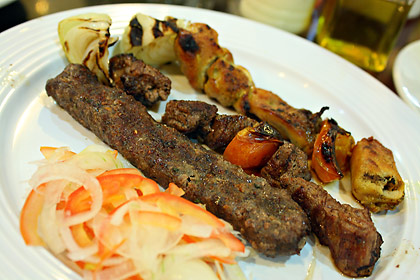
Beef and chicken kebab on a plate; the skewers have been removed.
Kebab is a meat dish popular not only in the Mid East but in South Asia and Asia Minor as well. It originated from Persia (modern day Iran) and is now famous globally. Kebab meat is either grilled, roasted or even stewed and while the traditionally preferred meat is lamb, it may also include beef or chicken meat. (Incidentally, our first experience of dining on lamb was in the Middle East.) Vegetables such as onions, tomatoes and bell peppers accompany the pieces of meat. Served on a skewer and grilled, it is called shish kebab.
Nuts are widely used in Middle Eastern, particularly Arabic, cuisine: almonds, pistachios and walnuts are often favored. Olives, dates and figs are also widely used. It appears that dates are used to break a fast during Ramadan. Partially dried dates are sometimes glazed with glucose syrup to make a simple snack but we prefer date biscuits and a type of date bar or pastry filled with date paste much like Fig Newtons.
Traditional dining in a Persian Gulf household is an interesting experience. Food is served on a carpeted floor with diners gathered in a circle around it (much like Leo’s experience in traditional households in Pakistan’s Khyber Pakhtunkhwa province). Eating is communal-style where people take food from common plates or a huge platter in the center of the circle (or a table in more modern settings) using the hands. Typically, diners scoop up hummus, mutabbal and other foodstuff using small pieces of pita bread. The right hand is used for eating; the left hand – reserved for hygienic purposes – is considered unclean (so do not attempt to shake hands with someone from the Mid East using your left hand).


